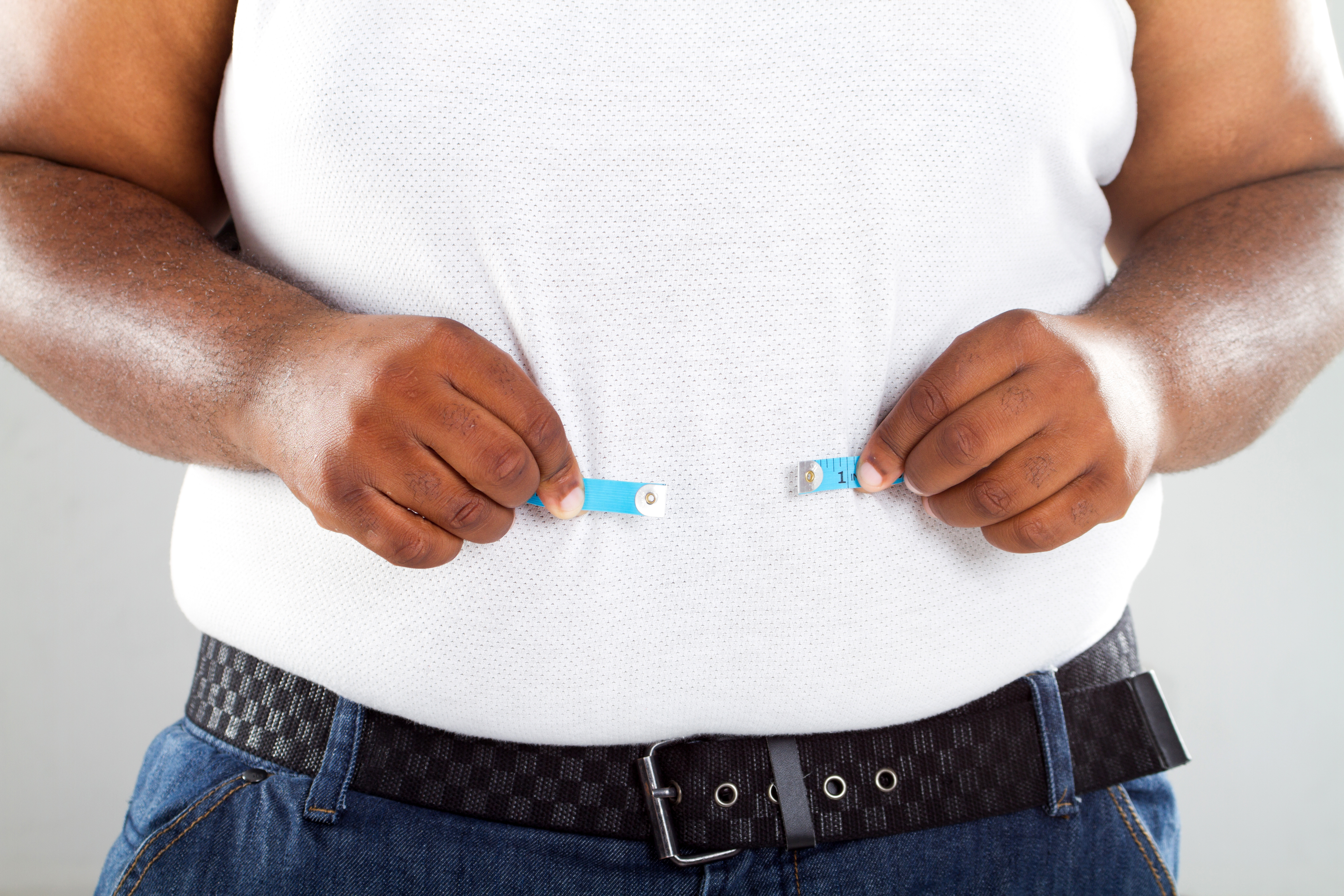“An ounce of prevention is worth a pound of cure.” This quote by Benjamin Franklin is the key to your health. It ‘d be nice if people would do more to reduce the risk factors of diseases such as diabetes, hypertension, cancer and many others. Jay Harold will talk about a risk factor he knows well. Jay Harold comes from a family with plenty of obese and overweight people.
Obesity is one of the major risk factors facing Black Americans today. These facts from the Office of Minority Health1 points this out:
- In 2014, African Americans were 1.5 times as likely to be obese as Non- Hispanic Whites.
- In 2011-2014, African American girls were 50% more likely to be overweight than Non-Hispanic White girls.
- In 2014, African American women were twice as likely to be obese than Non-Hispanic White women.
You know the routine for better health; better diet, exercise regularly and stop smoking are important in reducing the disease threat. Jay Harold will talk about a proven diet plan that can lead you to better health. The National Institutes of Health developed the DASH2 “Dietary Approaches to Stop Hypertension” diet plan. A healthy eating plan such as DASH can both reduce the risk of developing high blood pressure and lower a blood pressure that is already too high.
For an overall eating plan, consider DASH, because it can help you maintain or lose weight. You can reduce your blood pressure by eating foods that are low in saturated fat, total fat, and cholesterol, and high in fruits, vegetables, and low-fat dairy foods. The DASH eating plan includes whole grains, poultry, fish, and nuts, and has small amounts of fats, red meats, sweets, and sugared beverages. It is also high in potassium, calcium, and magnesium, as well as protein and fiber. Eating foods lower in salt and sodium also can reduce blood pressure.
DASH is an eating plan that helps create a heart-healthy eating style for life.
The DASH eating plan requires no special foods
The DASH eating plan requires no special foods and instead provides daily and weekly nutritional goals. This plan3 recommends:
- Eating vegetables, fruits, and whole grains
- Including fat-free or low-fat dairy products, fish, poultry, beans, nuts, and vegetable oils
- Limiting foods that are high in saturated fat, such as fatty meats, full-fat dairy products, and tropical oils such as coconut, palm kernel, and palm oils

- Limiting sugar-sweetened beverages and sweets.
Based on these recommendations, the following table shows examples of daily and weekly servings that meet DASH eating plan targets for a 2,000-calorie-a-day diet.
Daily and Weekly DASH Eating Plan Goals for a 2,000-Calorie-a-Day Diet
| Food Group |
Daily Servings |
|---|---|
| Grains |
6–8 |
| Meats, poultry, and fish |
6 or less |
| Vegetables |
4–5 |
| Fruit |
4–5 |
| Low-fat or fat-free dairy products |
2–3 |
| Fats and oils |
2–3 |
| Sodium |
2,300 mg* |
| Weekly Servings | |
| Nuts, seeds, dry beans, and peas |
4–5 |
| Sweets |
5 or less |
*1,500 milligrams (mg) sodium lowers blood pressure even further than 2,300 mg sodium daily.
When following the DASH eating plan, it is important to choose foods that are:
- Low in saturated and trans fats
- Rich in potassium, calcium, magnesium, fiber, and protein
- Lower in sodium
Following the DASH Eating Plan
The DASH eating plan is easy to follow using common foods available in your grocery store. The program includes daily servings from different food groups. The number of servings you should have depends on your daily calorie (energy) needs.
To figure out your calorie needs, you need to consider your age and physical activity level. If you want to maintain your current weight, you should eat only as many calories as you burn by being physically active. This is called energy balance. (For more information about energy balance, go to the Health Topics Overweight and Obesity article.)
If you need to lose weight, you should eat fewer calories than you burn or increase your activity level to burn more calories than you eat.
Consider your physical activity level. Are you sedentary, moderately active, or active?
- Sedentary means that you do only light physical activity as part of your typical daily routine.
- Moderately active means that you do physical activity equal to walking about 1.5 to 3 miles a day at 3 to 4 miles per hour, plus light physical activity.
- Active means that you do physical activity equal to walking more than 3 miles per day at 3 to 4 miles per hour, plus light physical activity.
Use the chart below to estimate your daily calorie needs.
Daily Calorie Needs for Women
| Age (years) | Calories Needed for Sedentary Activity Level | Calories Needed for Moderately Active Activity Level | Calories Needed for Active Activity Level |
|---|---|---|---|
| 19–30 | 2,000 | 2,000–2,200 | 2,400 |
| 31–50 | 1,800 | 2,000 | 2,200 |
| 51+ | 1,600 | 1,800 | 2,000–2,200 |
Daily Calorie Needs for Men
| Age (years) | Calories Needed for Sedentary Activity Level | Calories Needed for Moderately Active Activity Level | Calories Needed for Active Activity Level |
|---|---|---|---|
| 19–30 | 2,400 | 2,600–2,800 | 3,000 |
| 31–50 | 2,200 | 2,400–2,600 | 2,800–3,000 |
| 51+ | 2,000 | 2,200–2,400 | 2,400–2,800 |
After figuring out your daily calorie needs, go to the table below and find the closest calorie level to yours. This table estimates the number of servings from each food group that you should have. Serving quantities are per day, unless otherwise noted.
DASH Eating Plan—Number of Food Servings by Calorie Level
| Food Group | 1,200 Cal. |
1,400 Cal. |
1,600 Cal. |
1,800 Cal. |
2,000 Cal. |
2,600 Cal. |
3,100 Cal. |
|---|---|---|---|---|---|---|---|
| Grainsa | 4–5 | 5–6 | 6 | 6 | 6–8 | 10–11 | 12–13 |
| Vegetables | 3–4 | 3–4 | 3–4 | 4–5 | 4–5 | 5–6 | 6 |
| Fruits | 3–4 | 4 | 4 | 4–5 | 4–5 | 5–6 | 6 |
| Fat-free or low-fat dairy productsb | 2–3 | 2–3 | 2–3 | 2–3 | 2–3 | 3 | 3–4 |
| Lean meats, poultry, and fish | 3 or less | 3–4 or less | 3–4 or less | 6 or less | 6 or less | 6 or less | 6–9 |
| Nuts, seeds, and legumes | 3 per week | 3 per week | 3–4 per week | 4 per week | 4–5 per week | 1 | 1 |
| Fats and oilsc | 1 | 1 | 2 | 2–3 | 2–3 | 3 | 4 |
| Sweets and added sugars | 3 or less per week | 3 or less per week | 3 or less per week | 5 or less per week | 5 or less per week | ≤2 | ≤2 |
| Maximum sodium limitd | 2,300 mg/day | 2,300 mg/day | 2,300 mg/day | 2,300 mg/day | 2,300 mg/day | 2,300 mg/day | 2,300 mg/day |
a Whole grains are recommended for most grain servings as a good source of fiber and nutrients.
b For lactose intolerance, try either lactase enzyme pills with dairy products or Lactose-free or lactose-reduced milk.
c Fat content changes the serving amount for fats and oils. For example, 1 Tbsp regular salad dressing = one serving; 1 Tbsp low-fat dressing = one-half serving; 1 Tbsp fat-free dressing = zero servings.
d The DASH eating plan has a sodium limit of either 2,300 mg or 1,500 mg per day.
DASH Eating Plan—Serving Sizes, Examples, and Significance
| Food Group | Serving Sizes | Examples and Notes | Significance of Each Food Group to the DASH Eating Plan |
|---|---|---|---|
| Grainsa |
1 slice bread
1 oz dry cerealb
½ cup cooked rice, pasta, or cerealb
|
Whole-wheat bread and rolls, whole-wheat pasta, English muffin, pita bread, bagel, cereals, grits, oatmeal, brown rice, unsalted pretzels and popcorn | Major sources of energy and fiber |
| Vegetables |
1 cup raw leafy vegetable
½ cup cut-up raw or cooked vegetable
½ cup vegetable juice
|
Broccoli, carrots, collards, green beans, green peas, kale, lima beans, potatoes, spinach, squash, sweet potatoes, tomatoes | Rich sources of potassium, magnesium, and fiber |
| Fruits |
1 medium fruit
¼ cup dried fruit
½ cup fresh, frozen, or canned fruit
½ cup fruit juice
|
Apples, apricots, bananas, dates, grapes, oranges, grapefruit, grapefruit juice, mangoes, melons, peaches, pineapples, raisins, strawberries, tangerines | Important sources of potassium, magnesium, and fiber |
| Fat-free or low-fat dairy productsc |
1 cup milk or yogurt
1½ oz cheese
|
Fat-free milk or buttermilk; fat-free, low-fat, or reduced-fat cheese; fat-free/low-fat regular or frozen yogurt | Major sources of calcium and protein |
| Lean meats, poultry, and fish |
1 oz cooked meats, poultry, or fish
1 egg
|
Select only lean; trim away visible fats; broil, roast, or poach; remove skin from poultry | Rich sources of protein and magnesium |
| Nuts, seeds, and legumes |
⅓ cup or 1½ oz nuts
2 Tbsp peanut butter
2 Tbsp or ½ oz seeds
½ cup cooked legumes (dried beans, peas)
|
Almonds, filberts, mixed nuts, peanuts, walnuts, sunflower seeds, peanut butter, kidney beans, lentils, split peas | Rich sources of energy, magnesium, protein, and fiber |
| Fats and oilsd |
1 tsp soft margarine
1 tsp vegetable oil
1 Tbsp mayonnaise
2 Tbsp salad dressing
|
Soft margarine, vegetable oil (canola, corn, olive, safflower), low-fat mayonnaise, light salad dressing | The DASH study had 27% of calories as fat, including fat in or added to foods |
| Sweets and added sugars |
1 Tbsp sugar
1 Tbsp jelly or jam
½ cup sorbet, gelatin dessert
1 cup lemonade
|
Fruit-flavored gelatin, fruit punch, hard candy, jelly, maple syrup, sorbet and ices, sugar | Sweets should be low in fat |
Whole grains are recommended for most grain servings as a good source of fiber and nutrients.
b Serving sizes vary between ½ cup and 1¼ cups, depending on cereal type. Check the product’s Nutrition Facts label.
c For lactose intolerance, try either lactase enzyme pills with dairy products or Lactose-free or lactose-reduced milk.
d Fat content changes the serving amount for fats and oils. For example, 1 Tbsp regular salad dressing = one serving; 1 Tbsp low-fat dressing = one-half serving; 1 Tbsp fat-free dressing = zero servings.
The DASH Eating Plan as Part of a Heart-Healthy Lifestyle
The DASH eating plan is just one essential part of a heart-healthy way of life, and combining it with other lifestyle changes such as physical activity can help you control your blood pressure and LDL-cholesterol for life.
To help prevent and control high blood pressure:
- Be physically active.
- Maintain a healthy weight.
- Limit alcohol intake.
- Manage and cope with stress.
Other lifestyle changes can improve your overall health, such as:
- If you smoke, quit.
- Get plenty of sleep.
Living With the DASH Eating Plan
Understanding the DASH eating plan will help you start and follow this plan for life.
Controlling Daily Sodium and Calories
To benefit from the proven DASH eating plan, it is important to limit daily sodium levels to 2,300 mg, or 1,500 mg if desired, and to consume the appropriate amount of calories to maintain a healthy weight or lose weight if needed.
Ways to Control Sodium Levels
The key to lowering your sodium intake is to make healthier food choices when you’re shopping, cooking, and eating out.
Tips for Lowering Sodium When Shopping, Cooking and Eating Out
|
Shopping |
Cooking |
Eating Out |
|---|---|---|
|
|
|
*Examples of convenience foods are frozen dinners, prepackaged foods, and soups; examples of condiments are mustard, ketchup, soy sauce, barbecue sauce, and salad dressings.
Most of the sodium Americans eat from processed and prepared foods, such as breads, cold cuts, pizza, poultry, soups, sandwiches and burgers, cheese, pasta and meat dishes, and salty snacks. Therefore, healthier choices when shopping and eating out are of particular importance.
Ways to Control Calories
To benefit from the DASH eating plan, it is important to consume the appropriate amount of calories to maintain a healthy weight. To help, read nutrition labels on food, and plan for success with DASH eating plan sample menus and other heart-healthy recipes.
The DASH eating plan can be used to help you lose weight. To lose weight, follow the DASH eating plan and try to reduce your total daily calories gradually. Find out your daily calorie needs or goals with the Body Weight Planner and calorie chart. Talk with your doctor before beginning any diet or eating plan.
General tips for reducing daily calories include:
- Eat smaller portions more frequently throughout the day.
- Reduce the amount of meat that you eat while increasing the number of fruits, vegetables, whole grains, or dry beans.
- Substitute low-calorie foods, such as when snacking (choose fruits or vegetables instead of sweets and desserts) or drinking (choose water instead of soda or juice), when possible.
Increasing Daily Potassium
The DASH eating plan is designed to be rich in potassium, with a target of 4,700 mg potassium daily, to enhance the effects of reducing sodium on blood pressure. The following are examples of potassium-rich foods.
Sample Foods and Potassium Levels
|
Food |
Potassium (mg) |
|---|---|
| Potato, 1 small |
738 |
| Plain yogurt, nonfat or low-fat, 8 ounces |
530–570 |
| Sweet potato, 1 medium |
542 |
| Orange juice, fresh, 1 cup |
496 |
| Lima beans, ½ cup |
478 |
| Soybeans, cooked, ½ cup |
443 |
| Banana, 1 medium |
422 |
| Fish (cod, halibut, rockfish, trout, tuna), 3 ounces |
200–400 |
| Tomato sauce, ½ cup |
405 |
| Prunes, stewed, ½ cup |
398 |
| Skim milk, 1 cup |
382 |
| Apricots, ¼ cup |
378 |
| Pinto beans, cooked, ½ cup |
373 |
| Pork tenderloin, 3 ounces |
371 |
| Lentils, cooked, ½ cup |
365 |
| Kidney beans, cooked, ½ cup |
360 |
| Split peas, cooked, ½ cup |
360 |
| Almonds, roasted, ⅓ cup |
310 |
Meal Planning and Tips
NHLBI meal planning tools and tips can help you follow the DASH eating plan to meet nutritional goals.
Meal Planning Tools
The following tools can help you prepare and choose meals that meet the nutritional goals of the DASH eating plan.
- NHLBI In-Brief: Your Guide to Lowering Your Blood Pressure with DASH: Contains a DASH log for tracking daily food and physical activity levels and a shopping and menu planner.
- Weekly DASH menus: Provides sample daily DASH eating plan menus at 1,500 mg or 2,300 mg daily sodium levels. These menus are based on a 2,000-calorie-per-day diet and suggested serving sizes may be adjusted if other daily calorie targets are desired.
- Heart-healthy recipes: Provide additional ideas for menu planning.
Tips for Lifelong Success
When changing lifestyle habits, it is normal to slip off track occasionally. Follow these tips to get you back on track.
- Ask yourself why you got off track. Find out what triggered your sidetrack, and restart the DASH eating plan.
- Don’t worry about a slip. Everyone slips, especially when learning something new. Remember that changing your lifestyle is a long-term process.
- Don’t change too much at once. When starting a new lifestyle, try to avoid changing too much at once. Slow changes lead to success.
- Break down the process. Break goals into smaller, simpler steps, each of which is attainable.
- Write it down. Use the Daily DASH Log to keep track of what you eat and what you’re doing while you are eating. You may find that you eat unhealthy foods while watching television. If so, you could start keeping a healthier substitute snack on hand.
- Celebrate success. Instead of eating out to celebrate your accomplishments, try a night at the movies, go shopping, visit the library or bookstore, or watch your favorite TV show.
Following the DASH diet plan can be difficult. The fact that you can reduce the number of drug medications is a tremendous benefit. Please consider incorporating this plan into your daily life.
Click this link to get free Health and Wealth information to improve your life. Play the free “Slow Roll Through Civil Rights” Game found on the Jay Harold website. Enjoyed this post? Share it and read more here.
Please take this advice of Muhammad Ali and give back to others. “Service to others is the rent you pay for your room here on earth.” ~ Muhammad Ali




